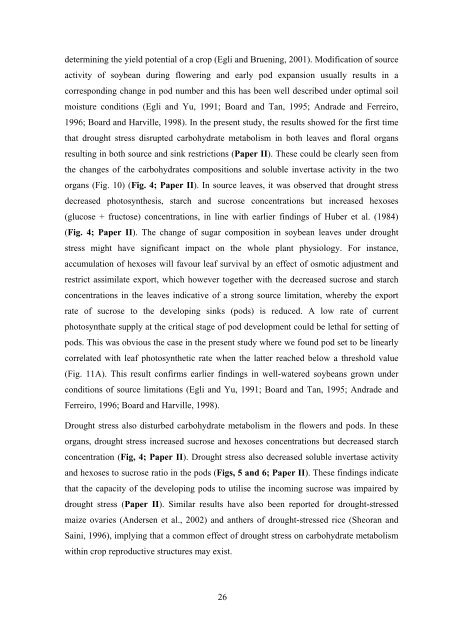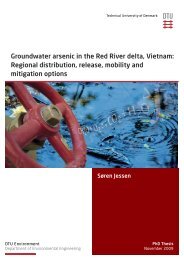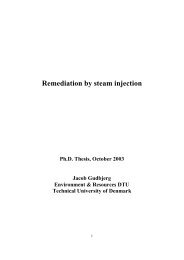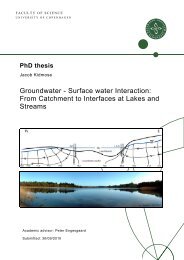Download PhD Thesis - Fiva
Download PhD Thesis - Fiva
Download PhD Thesis - Fiva
Create successful ePaper yourself
Turn your PDF publications into a flip-book with our unique Google optimized e-Paper software.
determining the yield potential of a crop (Egli and Bruening, 2001). Modification of source<br />
activity of soybean during flowering and early pod expansion usually results in a<br />
corresponding change in pod number and this has been well described under optimal soil<br />
moisture conditions (Egli and Yu, 1991; Board and Tan, 1995; Andrade and Ferreiro,<br />
1996; Board and Harville, 1998). In the present study, the results showed for the first time<br />
that drought stress disrupted carbohydrate metabolism in both leaves and floral organs<br />
resulting in both source and sink restrictions (Paper II). These could be clearly seen from<br />
the changes of the carbohydrates compositions and soluble invertase activity in the two<br />
organs (Fig. 10) (Fig. 4; Paper II). In source leaves, it was observed that drought stress<br />
decreased photosynthesis, starch and sucrose concentrations but increased hexoses<br />
(glucose + fructose) concentrations, in line with earlier findings of Huber et al. (1984)<br />
(Fig. 4; Paper II). The change of sugar composition in soybean leaves under drought<br />
stress might have significant impact on the whole plant physiology. For instance,<br />
accumulation of hexoses will favour leaf survival by an effect of osmotic adjustment and<br />
restrict assimilate export, which however together with the decreased sucrose and starch<br />
concentrations in the leaves indicative of a strong source limitation, whereby the export<br />
rate of sucrose to the developing sinks (pods) is reduced. A low rate of current<br />
photosynthate supply at the critical stage of pod development could be lethal for setting of<br />
pods. This was obvious the case in the present study where we found pod set to be linearly<br />
correlated with leaf photosynthetic rate when the latter reached below a threshold value<br />
(Fig. 11A). This result confirms earlier findings in well-watered soybeans grown under<br />
conditions of source limitations (Egli and Yu, 1991; Board and Tan, 1995; Andrade and<br />
Ferreiro, 1996; Board and Harville, 1998).<br />
Drought stress also disturbed carbohydrate metabolism in the flowers and pods. In these<br />
organs, drought stress increased sucrose and hexoses concentrations but decreased starch<br />
concentration (Fig, 4; Paper II). Drought stress also decreased soluble invertase activity<br />
and hexoses to sucrose ratio in the pods (Figs, 5 and 6; Paper II). These findings indicate<br />
that the capacity of the developing pods to utilise the incoming sucrose was impaired by<br />
drought stress (Paper II). Similar results have also been reported for drought-stressed<br />
maize ovaries (Andersen et al., 2002) and anthers of drought-stressed rice (Sheoran and<br />
Saini, 1996), implying that a common effect of drought stress on carbohydrate metabolism<br />
within crop reproductive structures may exist.<br />
26





